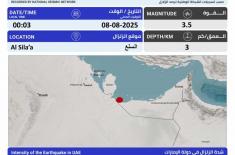
New Endoscopy Technology Improves Early Detection Of Esophageal Cancer
Mohammad Ali (@ChaudhryMAli88) Published August 08, 2025 | 10:00 AM

LONDON, (UrduPoint / Pakistan Point News / WAM - 08th Aug, 2025) Researchers from Helmholtz Munich, the Technical University of Munich (TUM) and the Medical University of Vienna have developed an advanced imaging technique called "O2E" that allows clinics to detect cancerous lesions in the esophagus with unprecedented precision.
Published in Nature Biomedical Engineering, the study demonstrated that this innovative endoscopy technology reveals even the smallest pathological tissue changes, significantly improving early detection and diagnosis.
Esophageal cancer ranks among the deadliest cancers: when diagnosed at an advanced stage, the survival rate is only about ten percent. However, if detected early, around 90 percent of patients survive. The new O2E technology could play a crucial role in identifying changes in esophageal tissue at much earlier stages.
O2E combines two imaging techniques in a new endoscopy technology. While OCT is particularly effective at capturing tissue structures, optoacoustic imaging (OPAM) – a method that stimulates tissue with light pulses and detects ultrasound signals resulting from the illumination – can visualise even the smallest blood vessels in deeper tissue layers.
By merging these techniques, high-resolution 3D images of tissue structure and function in the esophagus are generated. Both sensors are integrated into an endoscopy capsule that scans the tissue in a full 360-degree angle.
“Our dual imaging system uncovers critical features of early cancer lesions, including microscopic structural changes beneath the mucosal surface and subtle microvascular alterations within the cancerous tissue, that previous methods were unable to detect,” said Prof. Vasilis Ntziachristos, Director at the Institute of Biological and Medical Imaging at Helmholtz Munich and Chair at TUM.
In their pilot study, the researchers examined the esophagus of animals and tissue samples from patients with Barrett’s esophagus, a precursor to esophageal cancer. They successfully identified distinct differences between healthy tissue, tissue with abnormal cellular changes, precancerous stages, and malignant tumors.
Initial proof-of-principle tests were carried out on the inner lip of a volunteer, as it shares similar tissue characteristics with the esophagus.
Recent Stories

Currency Rate In Pakistan - Dollar, Euro, Pound, Riyal Rates On 8 August 2025

Today Gold Rate in Pakistan 08 August 2025

3.5 magnitude tremor recorded in Al Sila' with no reported impact: NCM

Starvation, malnutrition devastating Gaza: UN

Punjab Life Insurance Company to serve as pro-people institution: Minister Mujta ..

Minor molested in Hazro, Attock

Mushahid launches ‘Pakistan Zindabad’ conferences in Karachi

Mansour bin Zayed meets with departing Ukrainian Ambassador

Governor Sindh Kamran Khan Tessori attends ‘Maarka-e-Haq Independence Day’ c ..

Dubai gears up for T100 Triathlon on 13-16 Nov 2025

NA Speaker expresses grief over passing of senior journalist’s mother

PAC orders physical verification of all KDA employees
More Stories From Middle East
-
New endoscopy technology improves early detection of esophageal cancer
7 minutes ago -
Japan's current account surplus grows 9% in H1
7 minutes ago -
Helicopter crashes on Mississippi River, killing 2 people
8 hours ago -

3.5 magnitude tremor recorded in Al Sila' with no reported impact: NCM
8 hours ago -

Starvation, malnutrition devastating Gaza: UN
8 hours ago -

Mansour bin Zayed meets with departing Ukrainian Ambassador
11 hours ago
-

Dubai gears up for T100 Triathlon on 13-16 Nov 2025
11 hours ago -

UAE carries out 65th airdrop of aid under 'Birds of Goodness' operation, delivers over 500 tonnes of ..
13 hours ago -

ASEAN Committee holds third meeting in Abu Dhabi
13 hours ago -

UAE, Russian Presidents discuss bilateral strategic partnership in Moscow
14 hours ago -

Fatima bint Mubarak approves structure of Supreme Committee for Fatima Bint Mubarak Excellence, Comm ..
15 hours ago -

BRIDGE official visit to Seoul strengthens UAE-South Korea media, tech collaboration ahead of BRIDGE ..
15 hours ago








